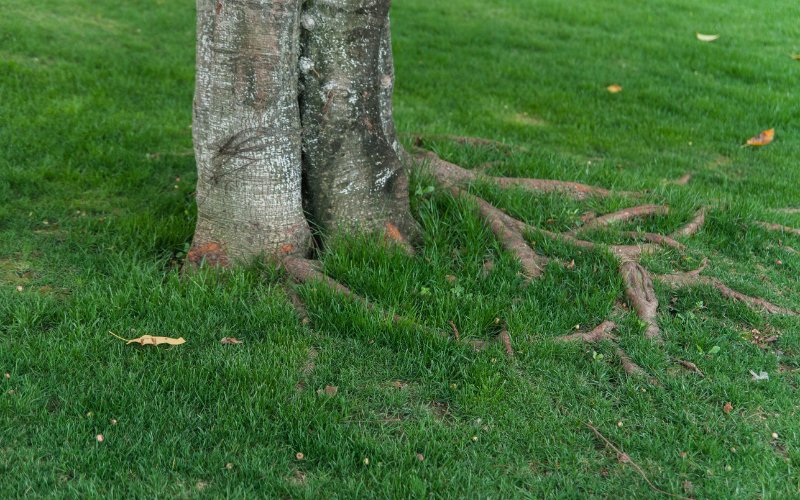It has taken me quite a few years to get my lawn to the standard I have been aiming for. I have my watering schedule dialed in, my fertilizing schedule all worked out, and I even ungraded my lawn mower to get a better cut. Just when I thought it was perfect, I started to notice some bumps in my lawn. I took a look and noticed a tree sprouting in the lawn. At first, I thought it was a weed until, on closer inspection, I discovered it was actually a sprout from a tree root. So, immediately I went to work. Here’s what I did.

Stopping Tree Roots from Sprouting in Your Lawn (The Short Explanation)
Tree root management is dealt with using two different methods: preventive and reactive. For new roots, you can use preventative methods like pruning new roots and root barriers. For existing tree roots, you can use reactive methods like root pruning and tree removal.
How to Stop Tree Roots from Sprouting in Your Lawn (3 Methods)
The method you decide to employ will depend on whether the roots you are dealing with are already in your lawn or if they are making their way close to your lawn. Here are some reactive and preventive methods you can use in your yard.
Reactive – Prune Existing Tree Roots
Root pruning is a method of cutting the existing roots of a tree so that they no longer cause a problem. Now, different-sized roots have to be dealt with in different ways. You can’t just cut off everything that’s causing a problem.
Roots with a diameter of less than 2” inches can be pruned up to 15% of the surface root and preferably no more. For anything bigger, you’ll need to measure the diameter of the trunk of the tree at about five feet off the ground, then times this number by five.
So, if you have a tree trunk with a two feet diameter, you can cut the root ten feet away from the tree.
Reactive – Tree Removal
If root pruning doesn’t take care of enough of the roots and you still have an issue with your lawn, then tree removal is an option. For example, if you have a tree with a two-foot diameter that is only 5 feet from the lawn, then you’ll have a five-foot overlap of the tree roots and your lawn. So, either the lawn has to give way, or the tree does.
Preventive – Pruning New Roots
One of the best ways to stop tree sprouts in lawns is to stop the roots from ever reaching the lawn. In this scenario, you would use the same method as before. Just this time, you’ll be working outside of the lawn area.
For example, I planted a tree in a flower bed that I know will cause a problem in the future. For now, I prune the tree roots while they are still growing in the flower bed.
Preventive – Blocking New Roots
So, a step beyond repeatedly having to prune the roots is to use a root-blocking material. Root barriers come in all different shapes and designs, ranging from solid plastic boards to plastic sheeting on a roll.
So, instead of having to continually dig up my flowers and lawn, I installed some high-density polyethylene sheeting. What this does is it stops trees from sprouting in the lawn by forming a barrier that new roots are too weak to get past. You are literally making a root barrier.
How to Stop Tree Roots from Sprouting in Your Lawn (The Steps)
Now that we’ve covered all of the different preventive and reactive methods let’s go over how to stop tree roots from sprouting in your lawn.
Root Pruning
Once you have measured the safe distance away for the tree trunk to prune, you can grab a shovel and expose the root. You only need to expose the section of the root you want to remove. There is no need to remove the entire root.
First, dig down a few inches below the bottom of the root so you have enough room for pruning. Then, take a pruning saw or just a regular wood saw and cut through the root. Then, move along the root and make a second cut to remove the surface root causing the issue.
Once the root is cut at both ends, you can remove it from the ground. Finally, backfill the hole, and you are done.
Tools to Tree Root Prune
- Shovel
- Hand Pruning Saw
Installing Root Barrier
In most cases, root barriers need to be buried at least 30 inches below the surface. This depth will take care of any surface root that might give you problems in the future. So, you’ll need to dig a trench 30 inches deep for as long as you think you will need.
In my case, I was concerned about 10 feet of the side of my lawn. So, I dug a trench 30 inches deep by 10 feet long. I made the trench the same width as my shovel. Then take your root barrier and place it into the trench, making sure it reaches the bottom.
Finally, backfill the trench with the dirt you previously removed. That’s really all there is to it. The trench took me some time to dig, but I still managed to get everything done in a single afternoon.
Tools & Materials to Install Tree Root Barrier
- Shovel
- Tree Root Barrier
Things to Be Careful of When Trying to Prevent Tree Roots from Sprouting
Before you think about cutting off too much of the problematic tree root, there are a couple of things you want to be aware of which could save you from some bigger problems. Let’s take a quick look.
Roots are the Tree’s Life Line
Keep in mind that if you cut back too much of the tree’s root, you’ll end up harming the tree. This is partly because the tree uses the roots for nutrients and water but more commonly because the tree can’t withstand the stress of pruning and root removal. So, to be on the safe side, cut roots longer rather than shorter.
Roots Stabilize the Tree
Different trees have different root systems, and they can vary in size and depth. But regardless of how their roots grow and look, they all provide stability for the tree. Trees like willow oak, pine oak, sycamore, and maple all have shallow root systems.
Therefore, root pruning will have a big effect on the tree’s stability. So, if you go too far with pruning, you could undermine the tree. The next time a storm rolls in, you could end up losing your tree.
A Few Tips to Help the Tree Root
Here are a couple of tree tips that can help you keep your tree’s surface roots under control and prevent them from getting out of hand.
- A tree can grow additional surface roots due to soil compaction. So, adding an inch or two of soil can help keep the roots lower in the ground.
- Trees will compete with lawns for nutrients and moisture and increase the size of their surface roots. So, keep your tree well-watered and fed.
- Overwatered trees can produce larger surface roots. So, don’t overwater, and take care of any standing water issues around trees.


Leave a Reply